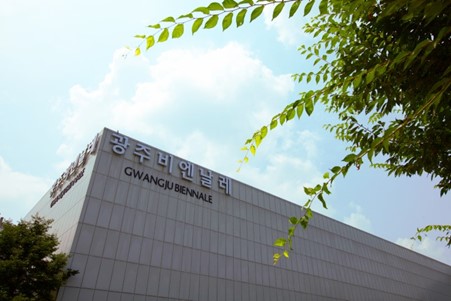Press
Resource Center
Gwangju Biennale Pavilion Project takes on largest-ever scale
“culture and art environment during the Gwangju Biennale”
- Nine Cultural organizations to participate, including the Netherlands, Switzerland, and other countries
- Organizations to be matched with culture and art institutions in Gwangju to showcase exhibitions
- Building sustainable exchange systems between local and overseas culture and art organizations

Gwangju Biennale Exhibition Hall
The Gwangju Biennale Foundation presents the Pavilion Project, which will take place during the 14th Gwangju Biennale. Initiated in 2018, the Gwangju Biennale Pavilion Project involves holding associated exhibitions with prominent overseas cultural organizations to bring the world’s art environments to Gwangju and communicate a message unique to the city. This year’s Pavilion Project is scheduled to be the largest in scale, with culture and art organizations taking part from nine countries, including Switzerland, Israel, and potentially Ukraine.
■ Expanded Pavilion Project takes on the largest-ever scale
In addition to its main exhibition, soft and weak like water, the 14th Gwangju Biennale also features the Pavilion Project, which is expected to generate synergistic effects as culture organizations take part in weaving the Gwangju area into a dynamic contemporary art environment.
With three institutions represented at the 12th Gwangju Biennale in 2018 and two at the 13th Gwangju Biennale in 2021, culture and art organizations from nine countries are slated to participate during the 14th edition of the Biennale.
The organizations taking part in this year’s Pavilion Project include Framer Framed, a contemporary culture and art institution in Amsterdam; the Embassy of Switzerland in the Republic of Korea; the Centre for Digital Art Holon in Israel; the Italian Cultural Institute in Seoul; the National Museum of China and China Cultural Center; the West Baffin Eskimo Cooperative Limited, an Inuit cooperative based in Kinngait, Canada; Poland’s Adam Mickiewicz Institute; and the Cultural Service of the French Embassy in the Republic of Korea.
These institutions are actively involved in the exchange of contemporary cultural, artistic, and visual environments between countries.
Similar to the Venice Biennale’s presentation of different national pavilions for countries to share their art, the Pavilion Project will serve as a platform for international interchange and publicity, inviting eminent culture and art organizations to present their country’s artists and artwork during the event. To ensure the Pavilion Project proceeds smoothly, the Gwangju Biennale Foundation has connected the participating overseas organizations with local culture and art institutions while working to create systems of cooperation and support exchange activities.
These institutions will begin installation around March to unveil their exhibitions in tandem with the opening of the Gwangju Biennale.
■ Cooperation with local cultural institutions: A cornerstone for building overseas networks
With the Pavilion Project also taking place throughout Gwangju over the 94 days of the Biennale from April 7 to July 9, visitors will have the opportunity to encounter dynamic aspects of contemporary art.
The project is independent of yet organically linked to the 14th Gwangju Biennale, with the participating overseas organizations working on their exhibitions in cooperation with their pre-matched culture and art institution counterparts in the Gwangju area.
Partner institutions in and around Gwangju include the Gwangju Museum of Art, leeleenam studio, Gwangju Media Art Platform, Dong-gok Museum of Art, Eunam Museum of Art, LeeKangHa Art Museum, 10 years later ground, Yangrim Gallery, and Gallery Podonamu.
These partner institutions have continued to introduce contemporary art to the Gwangju region over the years as representative local art institutions, alternative spaces, and private art institutions. These are the settings to accommodate the Pavilion Project during the 14th Gwangju Biennale, accompanied by various programs, including exchange exhibitions with the overseas organizations they are matched with.
For the Pavilion Project, the Foundation plans to set a virtuous cycle in motion within the art community through cooperation and expanded networks in the Gwangju region, while laying the groundwork for the partnered institutions to continue engaging in exchange and collaboration after the event has ended.
In the future, the project is also expected to promote academic exchange and yield new platforms for contemporary art discourses, such as curatorial workshops, publications, conferences, and symposiums.
“First conceived in 2018, the Gwangju Biennale Pavilion Project will be taking on its largest scale ever this year,” noted Gwangju Biennale Foundation President Yang-woo Park. “We want to create a system to promote international exchange and networks as we continue expanding the Pavilion Project,” he added.